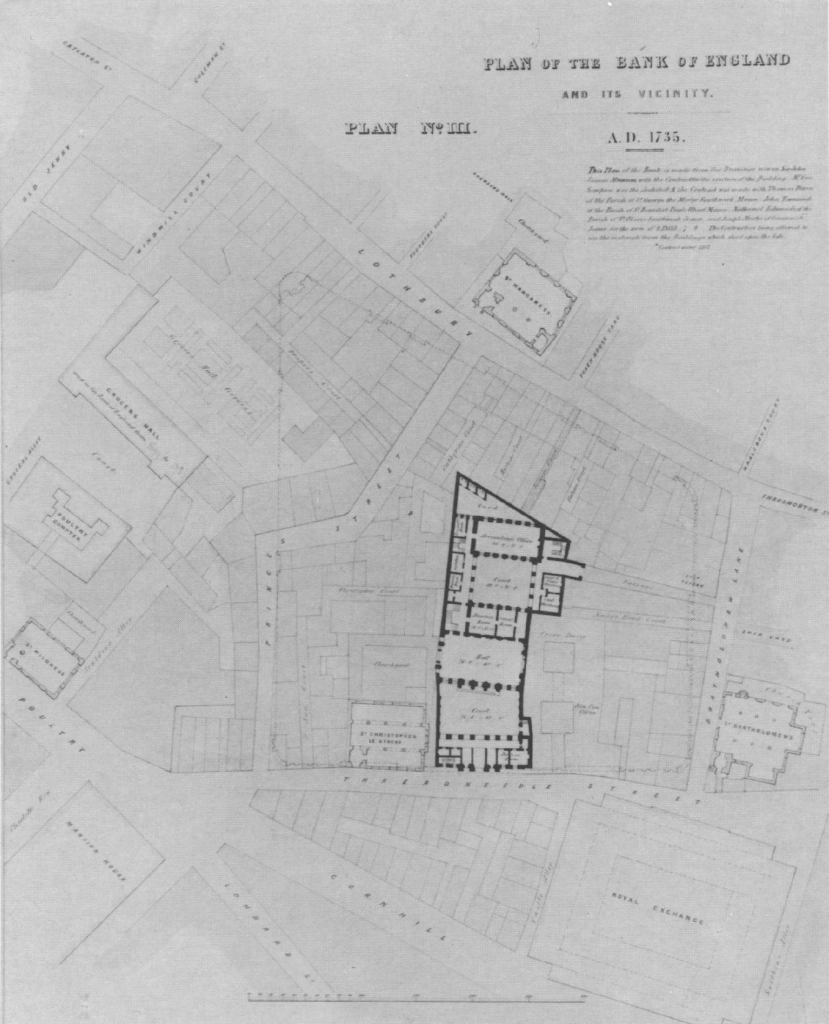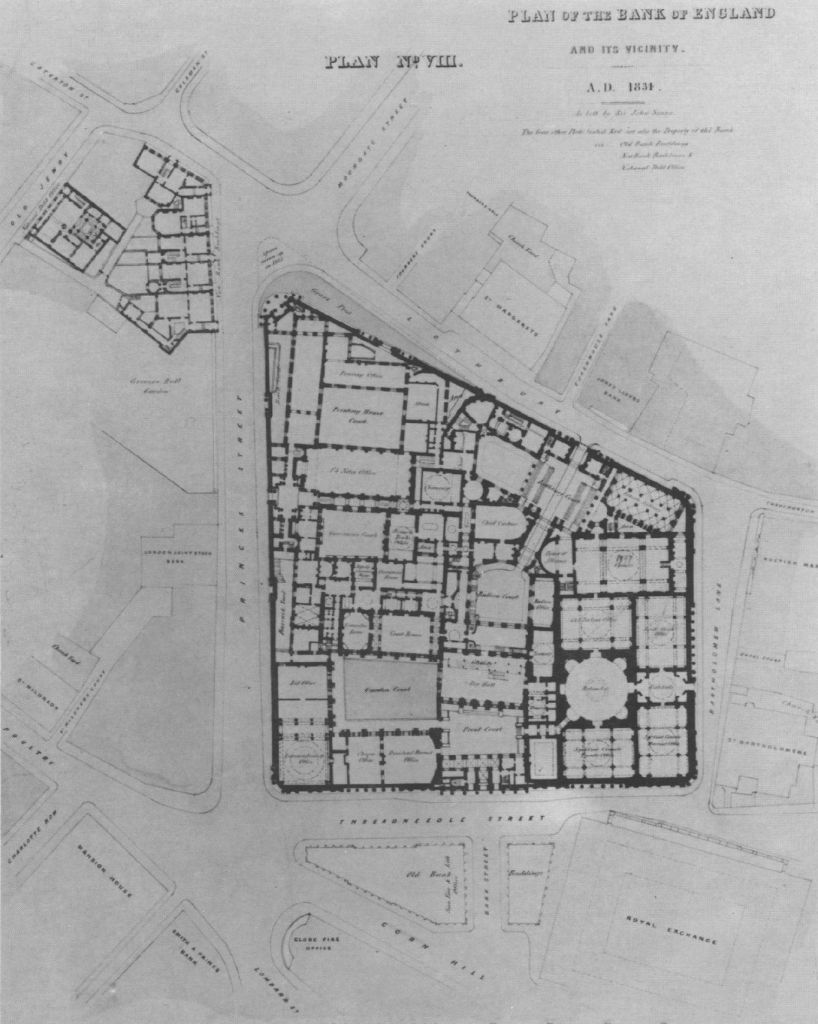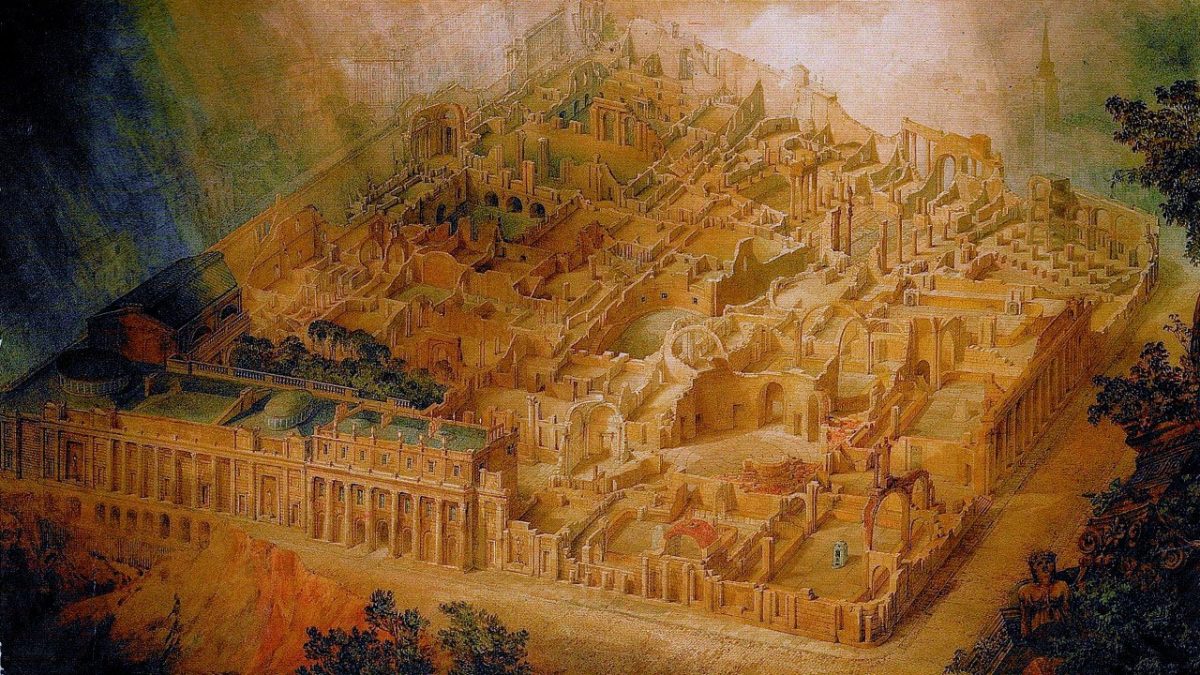Great Britain is one of the primary examples to observe when working to understand the reach of colonial, European imperialism. Cain and Hopkins observe that the onset of British Imperialism can be read two ways: one as the continuation of an existing system dominated by oligarchical land holders, and second as a consequence of the global, geopolitical changes that take place starting in 1688 and continue into the 19th century. Of special significance being the American Revolution in 1776 and the war with Napoleon’s France which ended in 1815.1 London, home of the British monarchy and its expanding imperial empire, was the site of significant urban, demographic and architectural changes during this period. One notable site that reflects these ongoing changes is the development of the Bank of England. Founded in 1694, the bank originated as an agreement between King William III and a collection of wealthy merchants, led by William Paterson, that became known as the City of London group. Parliament needed money to continue its efforts in war against France, and thus the merchants exploited this opportunity to form their own, publicly authorized commercial bank.2 What became known as the Bank of England evolved into a juggernaut institution that contributed to significant colonial expansion in the service of both the British nation and select powerful private interests that operated within the commonwealth. This separation of a private and public face of the bank was an important quality in building the myth around its identity. Outwardly, the bank represented the national interest and offered a service to those wishing to invest in an emerging capitalist ladder; one which British citizens were eager to climb. On the other hand, the bank was purpose built by and for a handful of wealthy merchant families, who wished for financial monopolies on specific sectors of Britain’s economy and its expanding colonial empire.3 Accordingly, the Bank of England should be regarded as a benchmark: the first building designed to serve a banking institution.

The Bank of England, more specifically John Soane’s rendition of the Bank of England, is an example of architecture deployed as a powerful visual, institutional tool in the persuasion of a growing British middle class. Built originally in 1694, the bank’s first modest building of its own was completed in 1734 after forty years of occupying a rented hall. Designed by George Sampson, a surveyor-turned-architect whose drawings won the competition that would determine who designed the building. According to the selection committee, Sampson’s submission was suitably classical and aligned to the desired style of the time. Additionally it met certain practical requirements including adequate natural light and had an easily accessible program split between the public and private sections of the building.4 While this first iteration of the Bank of England building laid the groundwork for expansion by future architects, it was still very much an attempt to construct a building that would be architecturally comparable to government buildings. As visitors entered the forecourt of the new bank building, they would immediately be faced with the figure of Britannia, a sculpted female figure whose identity drew connection between the constructed mythology of the British nation and its people.5 This type of design choice is just one example of how those in charge of the Bank of England worked to obscure its true purpose by presenting a public forum characterized by British nationalism.

Within a short period of time, it was realized that the Sampson’s design was spatially limited and would need renovation to accommodate the rapidly growing business the bank was tasked to manage. Britain was again engaged in war across the globe, competing with other European powers, Spain and France, to hold dominion over colonies in other parts of the world. In order to bankroll British participation in this widespread exploitation, parliament needed the support of both upper and middle classes; thus the bank needed to be bigger to accommodate the increasing number of people using its services. In 1764, former sculptor Robert Taylor was hired to manage the planned expansion of the bank building, a job which transitioned into designing the new sections that would be added to Sampson’s original design. The changes Taylor developed included additional stock transfer halls, a library for archiving bank records, but more notably a courtroom where the board of directors would gather to meet, and a series of private parlours built for individual use.6 These new additions built for the bank’s directorship were a stylistic departure from Sampson’s design, which by comparison were modestly neoclassical. Ornate, classically inspired decoration and a larger footprint characterized these new private spaces. Figurative iconography dressed the architecture of these new spaces, solidifying the directors’ commitment to the narrative of Brittania. In effect, this new substantial piece of the Bank of England was an elaborate, private space meant for the private dealings between Britain’s wealthiest individuals.
During Taylor’s tenure, the institution made gradual progress in acquiring the land fronting Threadneedle St., the road where the bank was situated. In line with the banks’ frequent collaboration with parliament, the two groups worked together to secure lands and development rights for the bank’s expansion. This coordination and proliferation was analogous to the expansion of colonial Britain, with both the state and state-sanctioned business operating without limits. During this same period of the bank’s growth, socio-political turmoil among the working class led to the Gordon Riots which took place in 1780. Parliament’s decision to return rights to Catholic Christians led to widespread conflicts among groups in London, and stirred up in this conflict were suspicions of the bank’s consolidation of wealth.7 This in turn led to Taylor taking further steps to ensure the building’s security, the most drastic of which was the construction of a barracks to house British soldiers who would defend the bank and its occupants from rioters.8 This emphasis on security as part of the bank’s design further cloistered the activities of the its directorship.

In 1788 Robert Taylor died and mere weeks later was replaced by John Soane; the most well-known of the architects who worked on the Bank of England building.9 Like the architect before him, Soane’s appointment was a consequence of his work in service of those wealthy merchants making up the bank’s directorship. His first works in charge dealt mostly with completing plans designed by Taylor, but in years proceeding this introductory labour Soane developed a powerful vision of what the Bank of England building should be. If Sampson’s and Taylor’s designs were classically influenced, Soane’s work was an effort to transplant classical architecture into downtown London. His designs combined these characteristics of Greek and Roman antiquity with an acceptance of new materials and techniques. One interesting facet of Soane’s time as architect, is his collaborative work with artist, JM Gandy, who created exaggerated, somewhat fantastic representations of what Soane wanted the bank to look like. Specifically in the bank’s stock office, one of the first major sections of the bank Soane completed, elements of the old and new came together in peculiar ways. Arches, and columns juxtaposed against cast-iron ornamentation and other reminders of modernity.10 It should be noted that at this stage in his career, John Soane received direct mentorship from George Dance, an architect who educated Soane and offered him many suggestions on his designs for the bank building. Summerson notes that Dance often passed sketches to Soane for interpretation and consideration, which at times Soane took as direct instruction on what to build. Accordingly, the resulting architecture lacked in the canonical order that characterized Sampson and Taylor’s decision making.11 This lack of organization brought plenty of criticisms to Soane’s architecture, which some argued was a clumsy interpretation of the classical ideal, and that other championed as development of a new formal language that incorporated Greek and Roman motifs.

In many ways Soane cared most deeply about the Vitruvian principles that determined his and many others’ architecture at the time. Unlike his peers, Soane actively worked to build a durable, secure building, prioritizing function over aesthetics.12 This strategy was heavily supported by the bank’s directorship, who above all else wanted the bank building to protect them and their dealings. The bank continued to grow over the course of Soane’s time as architect, and with that growth came a constant shifting and reorganization of space.13 Put simply, the influx of resources from British colonies enabled the bank to continually change shape, and in turn employed Soane to design and redesign its architecture for the better part of 30 years. As architecture and as an institution, the Bank of England shifted shape over the course of its existence. Both introducing a developing middle class to the capitalism championed by the banks leadership, and protecting the clandestine affairs of state-sponsored merchant operations. Soane stepped away from the bank in 1833, ending an era in its identity and portrayal. However, Soane’s impact as architect on the identity and mythology of the Bank of England cemented its place in British society for years to come.
- 1. Cain, P.J., & Hopkins, A.G. (2016). British Imperialism: 1688-2015 (3rd ed.). Routledge. https://doi-org.ezproxy.library.ubc.ca/10.4324/9781315677798 p. 73
- Abramson, Daniel. Building the Bank of England: Money, Architecture, Society 1694-1942 New Haven, US: Yale University Press, 2005. p. 5
- Schumann-Bacia, Eva John Soane and the Bank of England Essex, England: Longman Publishers, 1991. p. 10
- Abramson p. 45
- Abramson p. 53-54
- Abramson p. 66
- Schumann-Bachia p. 42
- Abramson p. 84
- Schumann-Bachia p. 44
- Schumann-Bachia p. 53-56
- Summerson, John. “The Evolution of Soane’s Bank Stock Office at the Bank of England.” Architectural History 27 (1984): 135-49. doi:10.2307/1568459. p. 137
- Schumann-Bachia p. 59
- Abramson p. 165
Bibliography
Abramson, Daniel. “C. R. Cockerell’s ‘Architectural Progress of the Bank of England’.” Architectural History 37 (1994): 112-29. doi:10.2307/1568638.
Abramson, Daniel. Building the Bank of England: Money, Architecture, Society 1694-1942 New Haven, US: Yale University Press, 2005.
Cain, P.J., & Hopkins, A.G. (2016). British Imperialism: 1688-2015 (3rd ed.). Routledge. https://doi-org.ezproxy.library.ubc.ca/10.4324/9781315677798
Schumann-Bacia, Eva John Soane and the Bank of England Essex, England: Longman Publishers, 1991.
Summerson, John. “The Evolution of Soane’s Bank Stock Office at the Bank of England.” Architectural History 27 (1984): 135-49. doi:10.2307/1568459.
